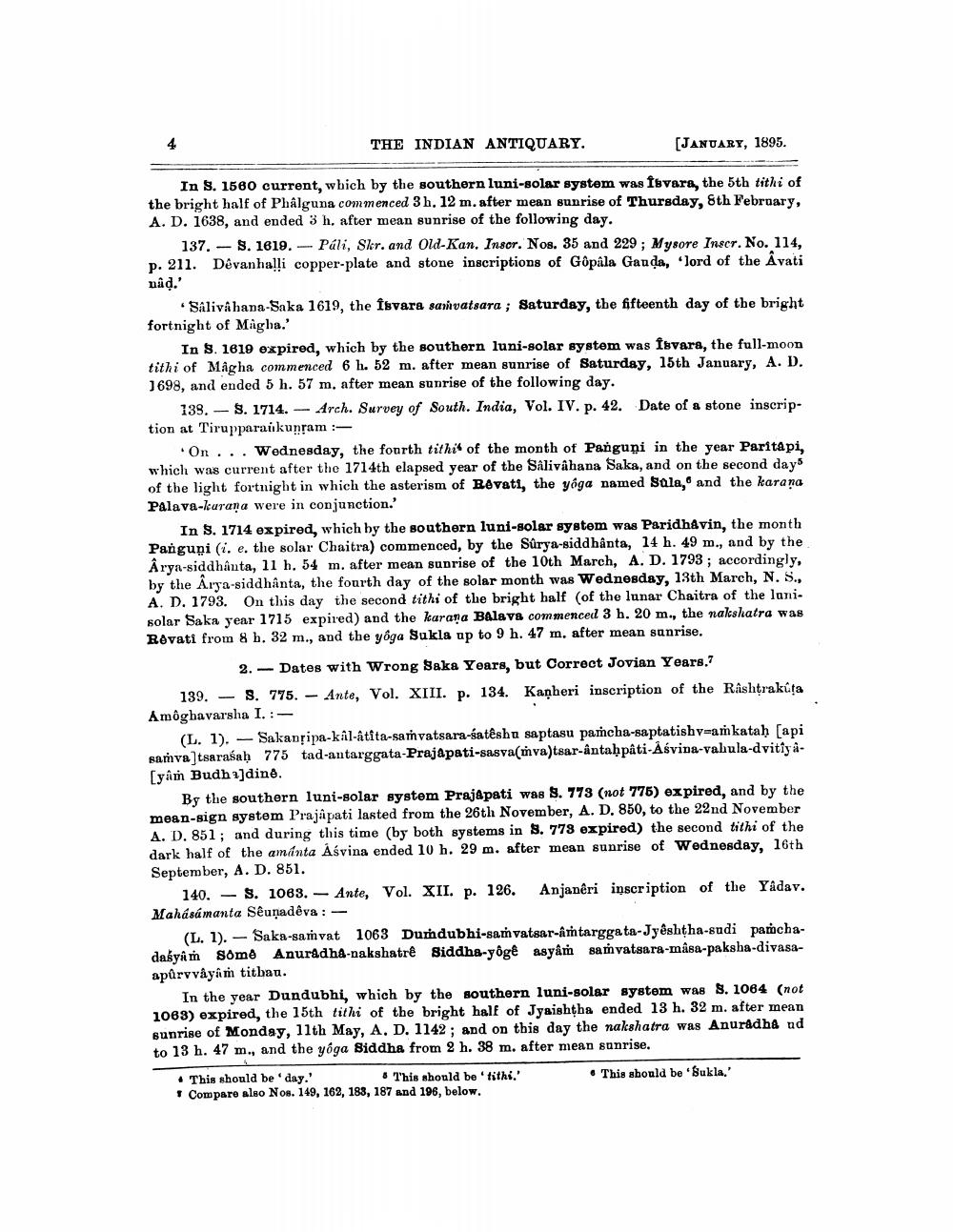Book Title: Indian Antiquary Vol 24 Author(s): Richard Carnac Temple Publisher: Swati Publications View full book textPage 8
________________ THE INDIAN ANTIQUARY. (JANUARY, 1895. In S. 1560 current, wbich by the southern luni-solar system was isvara, the 5th tithi of the bright half of Phâlguna commenced 3 h. 12 m. after mean sunrise of Thursday, 8th February, A. D. 1638, and ended 3 h. after mean sunrise of the following day. 137. - S. 1619. - Páli, Skr. and Old-Kan. Insor. Nos. 35 and 229; Mysore Inscr. No. 114, p. 211. Dévanhalli copper-plate and stone inscriptions of Gopala Ganda, lord of the Âvati nad.' Salivahana-Saka 1619, the Isvara sahvatsara ; Saturday, the fifteenth day of the bright fortnight of Migha.' In S. 1619 expired, which by the southern luni-solar system was Isvara, the full-moon tithi of Magha commenced 6 h. 52 m. after mean sunrise of Saturday, 15th January, A. D. J698, and ended 5 h. 57 m, after mean sunrise of the following day. 139.-. 1714. - Arch. Survey of South India, Vol. IV. p. 42. Date of a stone inscription at Tirupparaikunram : On ... Wednesday, the fourth tithit of the month of Panguni in the year Paritapi, which was current after the 1714th elapsed year of the Salivahana Saka, and on the second days of the light fortnight in which the asterism of Bevati, the yôga named Sala, and the karana Palava-kurana were in conjunction.' In S. 1714 expired, which by the southern luni-solar system was ParidhAvin, the month Panguni (i. e. the solar Chaitra) commenced, by the Súrya-siddhanta, 14 h. 49 m., and by the Arya-siddhanta, 11 h. 54 m. after mean sunrise of the 10th March, A. D. 1793 ; accordingly, by the Arya-siddhanta, the fourth day of the solar month was Wednesday, 13th March, N. S., A. D. 1793. On this day the second tithi of the bright half of the lunar Chaitra of the lunisolar Saka year 1715 expired) and the karana Balava commenced 3 h. 20 m., the nakshatra was Revati from 8 b. 32 m., and the yôga Sukla up to 9 h. 47 m. after mean sunrise. 2. - Dates with Wrong Saka Years, but Correct Jovian Years.7 139. – 3. 775. - Ante, Vol. XIII. p. 134. Kaņheri inscription of the Rashtrakuta Amôghavarsha I. : (L. 1). - Sakansipa-kal-âtita-samvatsara-satêshu saptasu pañcha-saptatishv-amkatah (api sanvaltsarasah 775 tad-antarggata-Prajapati-sasva(inva)tsar-antahpâti-Asvina-vahula-dvitiya(yam Budh 2]dine. By the southern luni-solar system Prajapati was $. 773 (not 775) expired, and by the mean-sign system Prajapati lasted from the 26th November, A. D. 850, to the 22nd November A. D. 851; and during this time (by both systems in S. 778 expired) the second tithi of the dark half of the amanta Aśvina ended 10 h. 29 m. after mean sunrise of Wednesday, 16th September, A. D. 851. 140. – S. 1063. - Ante, Vol. XII. p. 126. Anjaneri inscription of the Yadav. Mahásá manta Sêuñadêva : - (L. 1). - Saka-samvat 1063 Dundubhi-samvatsar-Arhtarggata-Jyêshtha-sudi parochadaśyam Some Anuradha-nakshatrê Siddha-yôge asyâm samvatsara-masa-paksha-divasaaparợ vayam titan. In the year Dundubhi, which by the southern luni-solar system was 8. 1064 (not 1063) expired, the 15th tithi of the bright half of Jyaishtha ended 13 h. 32 m. after mean sunrise of Monday, 11th May, A. D. 1142; and on this day the nakshatra was Anuradha nd to 13 h. 47 m., and the yoga Siddha from 2 h. 38 m. after mean sunrise. • This should be day.' This should be 'tithi.' • This should be 'Bukla, Compare also Nos. 149, 162, 183, 187 and 196, below.Page Navigation
1 ... 6 7 8 9 10 11 12 13 14 15 16 17 18 19 20 21 22 23 24 25 26 27 28 29 30 31 32 33 34 35 36 37 38 39 40 41 42 43 44 45 46 47 48 49 50 51 52 53 54 55 56 57 58 59 60 61 62 63 64 65 66 67 68 69 70 71 72 73 74 75 76 77 78 79 80 81 82 ... 390
